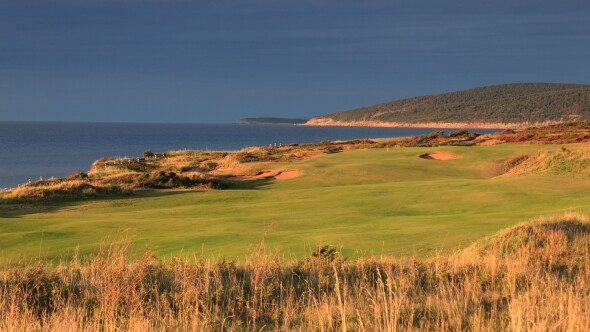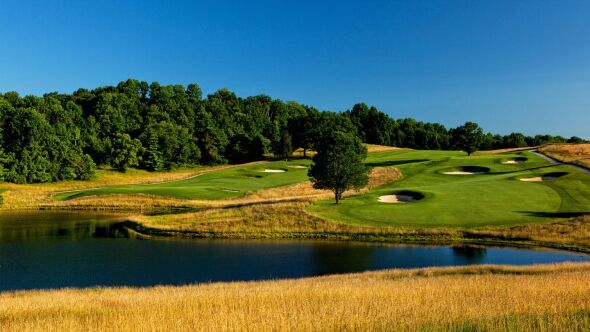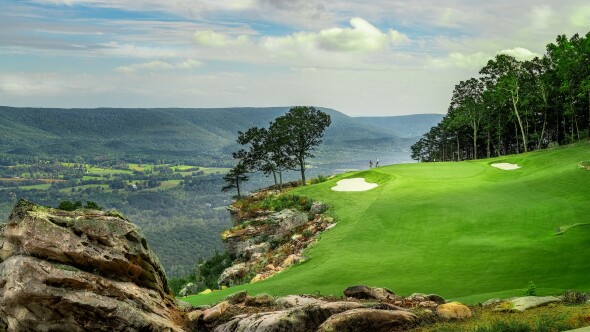It figures that “The Match” between Tiger Woods and Phil Mickelson on the Friday after Thanksgiving would be played on one of golf’s most expensive (to build) golf courses. If you’re going to preside over a $9 million, winner-take-all payday you might as well do it in Las Vegas, and on a course that in its day was notorious for having spent its way to the top.
Shadow Creek cost $37 million to build back in the late 1980s. That was a lot of money back then. Nowadays it buys you the services of a good NBA forward for a season. But spending that much money on a resort course made no sense in terms of meeting day-to-day operating expenses. It only could be justified as rational if your criteria for return-on-investment included sheer ego as well as indulging the high rollers at your casino hotel. Which is exactly what drove then-owner/developer Steve Wynn to make the leap.
Wynn hired Tom Fazio to turn an arid, featureless parcel of decomposed granite into a lush floral garden with rolling terrain, waterfalls and streams and 50-foot deep ravines. They utilized Hollywood-style dioramas to create mock-ups of every hole so Wynn could visualize the final product. Investing $21 million in trees helped create definition, as did the three-dimensional effects of elevated tees juxtaposed with the distant Sheep Range to the north. The course was an instant fixture on various top-100 lists, in the process creating a furor that the owners “spent their way to the top.”
Who cares what it cost as long as it looks great on TV? Or in this case, on Pay Per View.
Critics who claim that such an approach to design is “unnatural” might want to heed the wisdom of Pete Dye, who triumphed in the art of building art out of nothing. “If it were going to be entirely natural, it wouldn’t be a golf course,” he famously said.
That quotation helps explain the first example of sinking ego and money into a golf course: The Lido Club.
From 1914-1918, the father of American golf course architecture, Charles Blair Macdonald, dredged a monumental tract out of the muck fronting the Atlantic Ocean on Long Beach, Long Island, N.Y. It was a legendary project, with Macdonald and his trusted associate, Seth Raynor, creating the ground for their template holes (Redan, Channel, Punchbowl) by having crews pull two million cubic yards of sand out of a channel to plate the site, then hand-planting one million seaside plants to give the place a natural look.
The project cost $1.43 million, not including the clubhouse. That was 20-30 times what a standard 18-hole course cost in that era. By comparison, the ambitious 36-hole Oak Hill Country Club in Rochester, N.Y. cost $167,000 to build in 1922.
The Lido expenditure – equivalent to $23.9 million today – proved unsustainable. The course, while magnificent, carefully studied and widely acclaimed, did not live past World War II.
Donald Ross was well known for being efficient and parsimonious in his design work. The one notable exception came at George Wright Municipal Golf Course in Boston, which opened in 1938 after crews expended $1million on construction – an unprecedented amount for a city-owned course.
Walter Irving Johnson, Ross’ longtime civil engineer/design associate, undertook the site work on behalf of Boston’s Metropolitan District Commission, with considerable help from the federal Works Progress Administration and the labor of as many as 1,000 men at a time. Taming the rocky site entailed 30 tons of TNT, 11 miles of drainage pipe and jackhammering the irrigation system into place. All of that rock wasn’t wasted; it went into building a three-mile-long wall around the 155-acre course.
Eighty years after it opened - thanks in part to an ongoing restoration by architect Mark Mungeam - George Wright is a joy to play, with the tee sheet full and public golfers accessing the ground for a green fee of $39-$52.
It’ll cost considerably more than that to get on to ultra-private Liberty National Golf Club in Jersey City, N.J. How else could owner/developer Paul Foreman of Reebok fame recoup an investment of $250 million?
That’s what it took for co-designers Tom Kite and Bob Cupp to reverse nearly a century of industrial and petrochemical waste dumping. They needed 4 million cubic yards of fill to cover the place – enough to cover an entire football ball to a depth of 1,785 feet. Opened in 2006, the rehabilitated site now teems with wildlife and the course has proven worthy of the 2017 President’s Cup, two PGA Tour Barclays championships and a thriving private club membership. Of course it helps having stunning views of downtown Manhattan, Upper Hudson Bay and the Statue of Liberty.
Wild expenditures do not guarantee bankruptcy. Not yet, anyway, if the example of two contemporary courses is any guidepost.
A plaque on the first tee of Trump National Golf Club in Rancho Palos Verdes, Ca., 35 miles south of downtown L.A., proclaims the layout to be the most expensive course in the world. It also mistakenly equates expense with excellence. “No expense has been spared – ensuring this will be the greatest golf course in California - if not the world. Over 260 million dollars makes Trump National the most expensive golf course ever built.”

Its origins were more modest – slightly. Building anything on the California coast is expensive due to site sensitivity and strict regulation. The original incarnation, Ocean Trails Golf Club, cost “only” $126 million but failed just before opening because of landslides at least partly attributable to a leaky municipal sewage pipe buried deep underground. Insurance covered reconstruction, the original owners bowed out, and by the time the new ownership under the Trump banner oversaw repairs and partial rerouting the course cost twice as much. Part of that cost has been offset by pricey real estate on a corner of the property. But golf at that cost is tough to sustain.
And then there’s Trump Golf Links at Ferry Point in New York City, whose price tag is somewhere in the $180 million range, depending upon how you calculate costs. That’s because the municipally owned tract alongside the Bronx Borough approach to and from the Whitestone Bridge sits atop a landfill. Co-designers Jack Nicklaus and John Sanford did a brilliant job making the treeless landscape look a crumpled dunesland.
Capping that landfill cost north of $70 million alone, which would have yielded no revenue. So for the extra marginal cost the city got a golf course with spectacular views of the East River and downtown Manhattan. The golf doesn’t come cheap by New York City municipal standards, however: rates are $154-$185 for residents and $197-$224 for non-residents.
That’s still a lot less than a round at Shadow Creek, where access is limited to guests at MGM Resort International hotels, who then get the privilege of paying $500 for golf.
Or you can just imagine yourself there on Nov. 23 through Pay Per View for $19.99. There’s exquisite irony in the fact that the match takes place on a lavishly expensive, completely contrived piece of ground – one that almost looks natural, except that all if its most salient features are exaggerations of the real thing.












Don't forget Granite Links, which took all of the dirt from Boston's Big Dig, had a similar price tag to Ferry Point.
I'd pay $500 (or is it $600 now?) to play Shadow Creek... once. Same for Pebble Beach. I dropped good money to play the four in Kohler this year and I'll do it again to hit up Bandon. They are "bucket list" for a reason and I'm going to kick it sooner rather than later.
I'm just going to enjoy the match, played on a course most of would never see otherwise. And by the way, the side bet money- which there is one already made on the first hole for $200k- will go to charity. Thanks for the article, which includes some very enlightening golf course history.
How about Stone Eagle in Palm Desert by Tom Doak? I believe that one cost well over $100 million when it was built in the early 2000s, then foreclosed upon, and now owned by a group of investors including Charles Koch? One of the most visually spectacular courses I've ever played!
Nice piece Brad. Great info on the classic course costs.
http://machrihanishdunes.com/golf/photo-video/
Beauty, as they say is in the eye of the beholder.
Love playing the pricey tracks and my local munis.
If the Augusta National and Pine Valley of the world ever have an entry fee...sign me up!
This is a minor issue but what is "decomposed granite"? My geology coursework showed granite to be a nonorganic material, solid granite may erode into sand but it certainly does not rot.
I'm much more impressed by the work of David McLay Kidd's work at Machrahanish Dunes on the Kintyre Peninsula in Scotland. They disturbed only 7 of the 260 acres on the course during construction. There was no seeding, they just mowed the existing grasses to shape fairways. The bunkers were natural scrapes built by the giant hares that roam the property. There was no heavy equipment used during its building. I'm not suggesting every course be this natural, but it shows how overboard American course design has become.
machrahanishdunes.com
The Tiger-Phil match would have some value if they were playing for a favorite charity (Tigers Foundation or Breast Cancer Research) rather than making two fabulously wealthy pro-athletes get closer to billionaire status.
Going back to the 1980’s, I would
Suggest that Perry Hollow GC in New Durham NH would fit the bill. It had a
Wonderful putting green that was over an achre in size . The green is now gone and the course is renamed
Lake Winnepauskee C C.